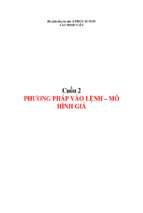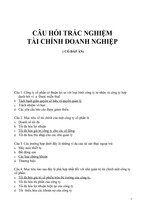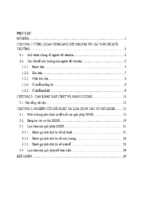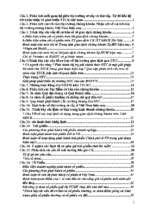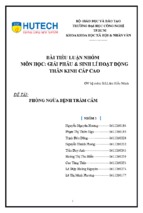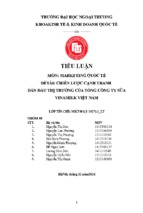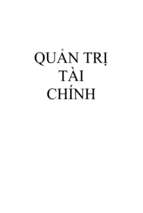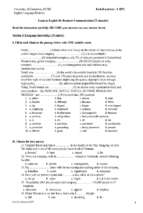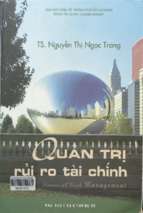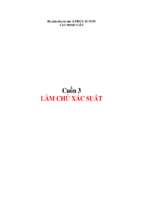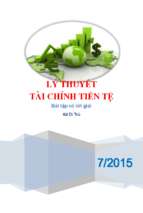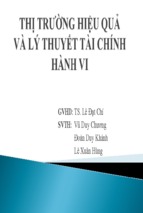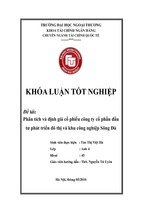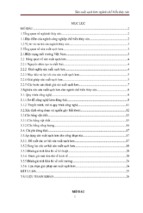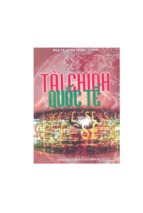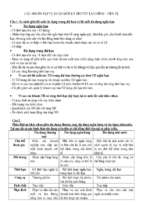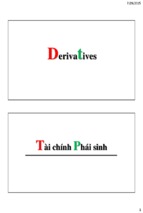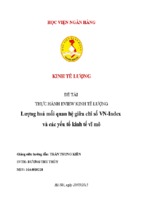Mô tả:
Fundamentals of Derivatives Markets (McDonald)
Chapter 3 Insurance, Collars, and Other Strategies
3.1 Multiple Choice Questions
1) A strategy consists of buying a market index product at $830 and longing a put on the index
with a strike of $830. If the put premium is $18.00 and interest rates are 0.5% per month,
what is the profit or loss at expiration (in 6 months) if the market index is $810?
A) $20.00 gain
B) $18.65 gain
C) $36.29 loss
D) $43.76 loss
Answer: D
2) A strategy consists of buying a market index product at $830 and longing a put on the index
with a strike of $830. If the put premium is $18.00 and interest rates are 0.5% per month,
compute the profit or loss from the long index position by itself expiration (in 6 months) if
the market index is $810.
A) $45.21 loss
B) $21.22 loss
C) $18.00 gain
D) $24.25 gain
Answer: A
3) A strategy consists of buying a market index product at $830 and longing a put on the index
with a strike of $830. If the put premium is $18.00 and interest rates are 0.5% per month,
compute the profit or loss from the long put position by itself (in 6 months) if the market
index is $810.
A) $3.45 gain
B) $1.45 gain
C) $2.80 loss
D) $1.36 loss
Answer: B
4) A strategy consists of buying a market index product at $830 and longing a put on the index
with a strike of $830. If the put premium is $18.00 and interest rates are 0.5% per month,
what is the estimated price of a call option with an exercise price of $830?
A) $42.47
B) $45.26
C) $47.67
D) $49.55
Answer: A
5) A strategy consists of longing a put on the market index with a strike of 830 and shorting a
call option on the market index with a strike price of 830. The put premium is $18.00 and the
call premium is $44.00. Interest rates are 0.5% per month. Determine the net profit or loss if
the index price at expiration is $830 (in 6 months).
A) $0
B) $23.67 loss
C) $26.79 gain
D) $28.50 gain
Answer: C
1
6) A strategy consists of longing a put on the market index with a strike of 830 and shorting a
call option on the market index with a strike price of 830. The put premium is $18.00 and the
call premium is $44.00. Interest rates are 0.5% per month. What is the breakeven price of the
market index for this strategy at expiration (in 6 months)?
A) $802.12
B) $830.00
C) $855.21
D) $866.32
Answer: C
7) At the 6-month point, what is the breakeven index price for a strategy of longing the market
index at a price of 830? Interest rates are 0.5% per month.
A) $802.12
B) $830.00
C) $855.21
D) $866.32
Answer: C
8) The $850 strike put premium is $25.45 and the $850 strike call is selling for $30.51. Calculate
the breakeven index price for a strategy employing a short call and long put that expires in 6
months. Interest rates are 0.5% per month.
A) $822.67
B) $824.79
C) $830.76
D) $875.82
Answer: B
9) What is the maximum profit that an investor can obtain from a strategy employing a long
830 call and a short 850 call over 6 months? Interest rates are 0.5% per month.
A) $6.80
B) $7.68
C) $9.24
D) $12.32
Answer: B
10) What is the maximum loss that an investor can obtain over 6 months from a strategy
employing a long 830 call and a short 850 call? Interest rates are 0.5% per month.
A) $6.80
B) $7.68
C) $9.24
D) $12.32
Answer: D
11) What is the break even point that an investor can obtain from a 6-month strategy employing
a long 830 call and a short 850 call? Interest rates are 0.5% per month.
A) $832.82
B) $842.32
C) $852.22
D) $862.92
Answer: B
2
12) The owner of a house worth $180,000 purchases an insurance policy at the beginning of the
year for a price of $1,000. The deductible on the policy is $5,000. If after 6 months the
homeowner experiences a casualty loss valued at $45,000, what is the homeownerʹs net
gain/loss? Assume an opportunity cost of capital of 4.0% annually.
A) $0
B) $1,000
C) $5,000
D) $6,020
Answer: D
13) Using option strategy concepts, what is the value of an insured home, if the value of the
uninsured home is $220,000, the house was purchased for $180,000 and the house has a
casualty policy costing $500 with a $2,000 deductible? Ignore interest costs.
A) $180,000
B) $217,500
C) $220,000
D) $222,500
Answer: B
14) An investor purchases a call option with an exercise price of $55 for $2.60. The same investor
sells a call on the same security with an exercise price of $60 for $1.40. At expiration, 3
months later, the stock price is $56.75. All other things being equal and given an annual
interest rate of 4.0%, what is the net profit or loss to the investor?
A) $1.21 loss
B) $1.50 loss
C) $0.54 gain
D) $1.65 gain
Answer: C
15) Which strategy is a bet that the actual volatility of an asset is low relative to the marketʹs
assessment?
A) Long Call
B) Long Put
C) Purchased straddle
D) Written straddle
Answer: D
16) What strategy is an investor most likely to employ to reduce the high premium cost
associated with a strangle strategy?
A) Butterfly spread
B) Strangle
C) Ratio call write
D) Bull spread
Answer: B
17) What strategy is an investor most likely to employ to insure against the losses associated
with a straddle write?
A) Butterfly spread
B) Strangle
C) Ratio call write
D) Bull spread
Answer: A
3
18) Which of the following strategies represents a purchased put and a written call for which the
premiums are equal?
A) Butterfly spread
B) Strangle
C) Ratio call write
D) Bull spread
Answer: D
19) The difference between the strike prices of a purchased put and a written call is the
________.
A) Butterfly spread
B) Strangle
C) Ratio call write
D) Bull spread
Answer: B
20) A position in which you buy a call and sell an otherwise identical call with a higher strike
price is called a ________.
A) Butterfly spread
B) Strangle
C) Ratio call write
D) Bull spread
Answer: D
3.2 Short Answer Essay Questions
1) Explain how a long stock and long put strategy equals the cash flow from a long call
strategy.
Answer: The net effect of the long put and long stock creates a cash flow identical to the long
call, provided you include the cost of funds.
2) Why might the manager of a portfolio employ a protective put strategy?
Answer: If the manager desires to protect against a price decline, but is restricted from selling
assets, a long put creates a floor below which losses cannot occur.
3) What is the difference between naked and covered call writing?
Answer: A covered position is one in which the individual also owns the underlying asset in
addition to the short call. A naked position involves writing the call alone.
4) What are the similarities and differences between bear and bull spreads?
Answer: Both have floors and ceilings. The bear position has a ceiling where prices are falling
and a floor where prices rise. A bull spread has the opposite floor and ceiling.
5) Why is a straddle position considered a speculation on the assetʹs volatility?
Answer: The strategy loses money if prices stay constant, but benefits from large changes in
prices, either up or down.
3.3 Class Discussion Question
1) Compare the butterfly spread, bear spread, bull spread, covered call, straddle, and other
strategies. Is any one strategy better than another? Are there trade-offs between each that is
almost perfect or do significant advantages exist from one strategy to another?
4
- Xem thêm -

